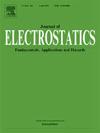三极管系统直流电晕放电的实验与数值研究
IF 2.1
4区 工程技术
Q3 ENGINEERING, ELECTRICAL & ELECTRONIC
引用次数: 0
摘要
电晕放电的一个实际应用是绝缘材料的静电充电,以赋予特定的电性能。“三极管”电极系统然后经常用于指导和控制电荷水平。本文的目的是通过数值和实验表征这种电极排列,以优化充电过程。在本工作中,采用了一种由一组平行导线组成的创新网格。利用COMSOL Multiphysics软件进行的二维模拟,这种新网格的几何形状有助于对三极管配置中的电晕放电进行数值研究。研究了线面间距、栅极间距、栅极线间间隙、外加电压极性和栅极电位等参数变化的影响。研究发现,在电极间空间引入栅极及其各参数的变化对放电特性有相当大的影响,改变了地平面上电场和空间电荷的幅度和形状。实验结果与仿真结果吻合良好,验证了新网格下数值模型的有效性。本文章由计算机程序翻译,如有差异,请以英文原文为准。
Experimental and numerical investigations of DC corona discharge in the triode system
One practical application of corona discharge is the electrostatic charging of insulating materials to confer specific electrical properties. The “triode” electrode system is then frequently used to direct and control the charge level. The aim of this article is to characterize numerically and experimentally this electrode arrangement in order to optimize the charging process. In the present work, an innovative grid consisting of a set of parallel wires was utilized. The geometry of this new grid facilitated a numerical investigation of corona discharge in the triode configuration by employing a 2D simulation performed in COMSOL Multiphysics software. The study explores the effect of variation of different parameters such as wire-to-plane distance, grid-to-plane spacing, inter-wire gap of the grid, applied voltage polarity and grid potential. It was found that the introduction of the grid into the inter-electrode space, as well as the variation of its various parameters, has a considerable impact on the discharge characteristics, modifying both the amplitude and the shape of the electric field and space charge on the ground plane. The results also show a satisfactory correlation between experimental and simulation values, confirming the validity of the numerical model with the new grid.
求助全文
通过发布文献求助,成功后即可免费获取论文全文。
去求助
来源期刊

Journal of Electrostatics
工程技术-工程:电子与电气
CiteScore
4.00
自引率
11.10%
发文量
81
审稿时长
49 days
期刊介绍:
The Journal of Electrostatics is the leading forum for publishing research findings that advance knowledge in the field of electrostatics. We invite submissions in the following areas:
Electrostatic charge separation processes.
Electrostatic manipulation of particles, droplets, and biological cells.
Electrostatically driven or controlled fluid flow.
Electrostatics in the gas phase.
 求助内容:
求助内容: 应助结果提醒方式:
应助结果提醒方式:


